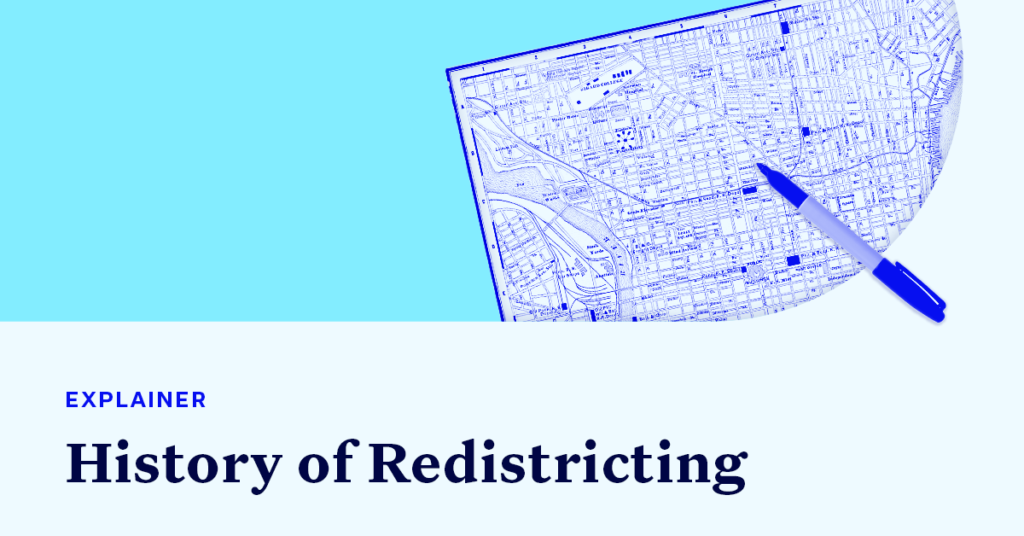Redistricting 101: How We Got Here

There’s something big looming on the horizon: redistricting. The U.S. Census Bureau will release its full data later this month, giving lawmakers the details they need about their state’s population changes to draw new maps. Due to the coronavirus, this data was delayed significantly — and states are already scrambling to catch up, changing their redistricting deadlines and asking their state courts for relief.
Before the real action kicks off, here’s an explainer on redistricting — what it is, how we got here and how partisan lawmakers can use it to their advantage. And if you need a refresher on some of the key terms, we’ve got you covered.
If you live in one of the 50 states, then you’re represented by a member of the U.S. House of Representatives. And who that member is depends on which congressional district you live in. You’re also represented by members of the two chambers of your state’s legislature. (Unless you live in Nebraska, that is! The Cornhusker State is the only one with a unicameral, or single-chamber, state legislature.) These state legislators are also elected to specially drawn districts.
But how exactly are your representatives determined? How do you end up in one legislative district while someone not so far away might end up in another? This is the result of redistricting, a process with vital implications for all Americans — especially for people of color since how and where district lines are drawn has a significant impact on the ability of different communities to elect representatives that reflect their interests.
Why do we draw (and redraw) districts?
Since 1929, there have been 435 members of the U.S. House of Representatives. Under Article I, Section 2 of the U.S. Constitution, these seats are apportioned to states based on their populations. Because a state’s districts are tied to its population, most states undertake a redistricting process after the results from each decennial census are released. (The exceptions are for states that are apportioned only one member of the House; currently, there are seven of them.)
States must undertake redistricting even if they neither gain nor lose congressional seats since the U.S. Supreme Court decided in Wesberry v. Sanders that congressional districts must be as nearly equal as possible to satisfy the 14th Amendment. This case was part of a series of decisions from the early 1960s that Chief Justice Earl Warren later concluded were the most important cases decided during his momentous tenure on the Court. The Warren Court also ruled that state legislative districts must also be roughly equal population-wise, so they also require redistricting every 10 years.
Who draws districts?
The Elections Clause of the U.S. Constitution provides that “[t]he Times, Places and Manner of holding Elections for Senators and Representatives”— which includes the apportionment of members of Congress — “shall be prescribed in each State by the Legislature thereof.” State legislatures therefore have the default power to conduct congressional redistricting.
But in Arizona State Legislature v. Arizona Independent Redistricting Commission, the Supreme Court confirmed that not only legislatures can undertake this process. Instead, states can also give this authority to commissions. Some states’ commissions are composed of elected officials, whereas others are independent bodies in an attempt to eliminate gerrymandering from the redistricting process — a concern building over recent decades, which is central to many of today’s voting rights reforms.
What is gerrymandering?
Gerrymandering is the process of drawing district boundaries to create a political advantage. The term originated in the early 19th century when Massachusetts Gov. Elbridge Gerry — soon to become vice president of the United States — signed a bill that redistricted state Senate districts in the Bay State. The Democratic-Republican Party drew the districts to increase their power, resulting in one oddly shaped district that, it was said, resembled a salamander. By combining the governor’s name with that creature, a Boston newspaper coined the term that today describes any manipulation of district lines for political advantage.
Partisan gerrymandering is when district lines are drawn to benefit a particular political party and increase its overall share of seats. This is often done in two ways:
- “Cracking” is the process of spreading members of a certain party among many districts to prevent them from forming an effective voting bloc in any one district.
- “Packing” is the concentration of voters into only a single district to reduce their voting influence in other districts.
After decades of punting the issue, the Supreme Court decided in Rucho v. Common Cause that partisan gerrymandering, unlike racial gerrymandering, is a political question beyond the review of any federal court. This means that although there are strong legal restrictions on gerrymandering based on race, there are currently no such federal restrictions on drawing purely partisan lines — although, of course, in many states, these divisions may end up looking the same.
Ultimately, during the upcoming round of redistricting, partisan gerrymandering will be fair game unless a state’s constitution prohibits it or Congress passes a law, like the For the People Act, that bans the practice.
Stay tuned for more information and resources about redistricting as we wait for the full release of 2020 census data.